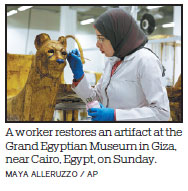Egypt begins restoration of King Tut's golden coffin
CAIRO - In a state-of-the art conservation laboratory in the Grand Egyptian Museum, the large gilded coffin of famed boy pharaoh Tutankhamun was placed inside a plastic incubator for sterilization. The objective is to restore this outermost coffin first time since it was discovered almost a century ago.
Soon after the discovery of the tomb, the inner and middle coffins were moved to the Egyptian Museum in Cairo, while the outer coffin was left inside the tomb.
"This coffin was kept inside the tomb of the king since it was discovered in Luxor in 1922,... It is at the Egyptian Grand Museum now for restoration because its status is very fragile," Egyptian Antiquities Minister Khaled al-Anany told reporters before he accompanied technicians to inspect the restoration work.

The minister said the sterilization work on King Tut's coffin started on July 22 at the wood restoration plant of the Grand Egyptian Museum, now being built near the famed pyramids of Giza outside Cairo in preparation for an intensive restoration process.
He said the initial examination showed that the coffin was suffering from general weakness and it also had developed cracks in its gilded plaster, especially in the lid and base.
King Tutankhamun, who ascended the throne at the age of nine and died at 19, is the world's best-known pharaoh of ancient Egypt. The young king ruled from 1332 BC to 1323 BC, during a period known as the New Kingdom in ancient Egypt.
His fame stems from his tomb, which was discovered by British Egyptologist Howard Carter in Luxor in 1922. It is one of the best preserved tombs.
The tomb contained three anthropoid coffins nested within each other.
The innermost coffin is mummy shaped and made of solid gold that weighs 110.4 kilograms. It was found wrapped in linen inside the middle coffin which is made of gilded wood inlaid with multicolored glass.
The middle coffin was found inside the outer gilded coffin now being restored. This coffin is also made of gilded wood portraying the king in the Osirian shape, with arms crossed upon his chest and holding the insignia, the flail and the crook ornamented with blue and red glass.
After the sterilization, Kamal said, restoration will take some eight months, noting that it will be displayed for the first time at the Grand Egyptian Museum in 2020.
With one of the most ancient civilizations, Egypt works hard to conserve its rich archaeological treasures and historical heritage. It may help boost the once-flourishing tourism industry that has suffered due to the political turmoil of the past five years.
Xinhua - Agencies
(China Daily 08/06/2019 page10)














